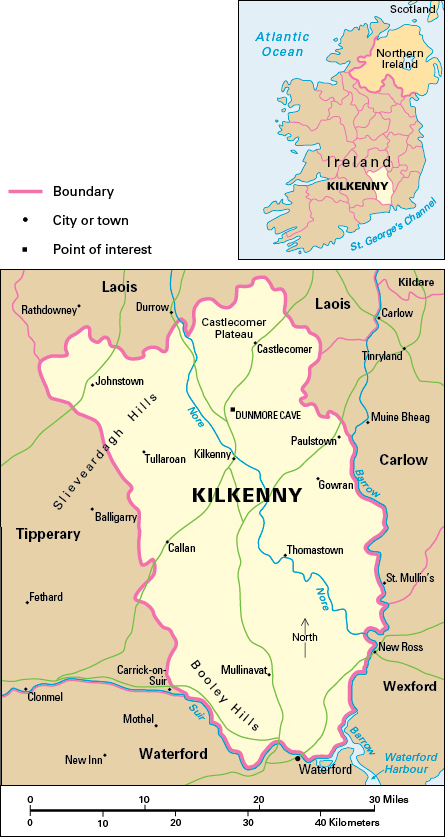Kilkenny, County, is in the province of Leinster in the Republic of Ireland. An inland county, it lies on the southeastern edge of Ireland’s central lowland. County Kilkenny covers an area of 796 square miles (2,062 square kilometers). The city of Kilkenny is the only large urban center in the county. The city is the county’s main center of manufacturing and services.

Most of the people of County Kilkenny are Roman Catholics. Most of the rest are members of the Church of Ireland or claim no religious affiliation. Local dioceses (districts) of both churches have their offices in the city of Kilkenny. St. Mary’s Cathedral of the Roman Catholic Church and St. Canice’s Cathedral of the Church of Ireland are also in the city.
Economy.
Most of the workers in County Kilkenny are employed in service industries, including education, health care and social work, public administration, and retail and wholesale trade. From the middle to late 1900’s, the Kilkenny Design Workshops developed programs to improve the quality of Irish design and industrial craftwork. The city of Kilkenny is the county’s main manufacturing center. Its largest industry is food processing. Brewing and light engineering are also important. Other industries include the production of machinery and of water treatment equipment.
Much of the county’s land is fertile farmland. Cattle production and dairy farming are the two main kinds of farming. Some farmers raise hogs. The main crops include barley, potatoes, and wheat. In addition, there is some forestry in upland areas.
County Kilkenny was once known for polished dark limestone known as “black marble.” Clay brick is made at Castlecomer.
Land.
The lowest parts of the county lie on limestone. They are mainly in the center of the county and along its southern and northwestern edges. The Castlecomer plateau in the northeast rises above the surrounding countryside and consists of sandstone and shale. Dunmore cave is open to the public.
Kilkenny is the county of “The Three Sisters”—the rivers Barrow, Nore, and Suir. These rivers flow toward Waterford Harbour. Much of the center and north of the county is drained by the Nore, which then joins the Barrow. The Suir forms the southern boundary.
History.
Saint Canice founded a church on the site of what is now the city of Kilkenny in the A.D. 500’s. In the Middle Ages (about A.D. 400 through the 1400’s), what is now County Kilkenny formed much of the Gaelic kingdom of Ossory. One of Ossory’s kings, Donal MacGillapatrick, founded the Cistercian abbey of Jerpoint near Thomastown in the 1100’s. The Cistercians are Roman Catholic monks and nuns. Beginning in the late 1100’s, the Anglo-Normans gained control of the county. They built many castles, churches, and monasteries. The Butlers, earls of Ormond, were the most important family. Their seat was first at Gowran, and later at the town of Kilkenny.
Today, the city of Kilkenny has many medieval remains, including St. Canice’s Cathedral and a fine castle overlooking the River Nore. The city played an important role in Anglo-Irish politics in the Middle Ages, serving as the site for many parliaments. A parliament in 1366 passed the Statutes of Kilkenny, which were an unsuccessful attempt to prevent the integration of the Anglo-Normans and the Irish. In the 1640’s, the city was the seat of the Confederation of Kilkenny, an alliance of old Irish and Anglo-Irish Catholic families. The population of County Kilkenny decreased from the 1840’s to the mid-1900’s. But it has grown steadily since the 1960’s.
